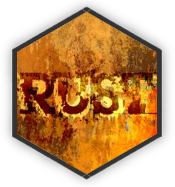See also RUSampling for a translation of rust into Python, courtesy of Lynne Jewson.
Ratio-of-uniforms simulation with transformation
What does rust do?
The rust package implements the multivariate generalized ratio-of-uniforms method of simulating random variates from a d-dimensional continuous distribution. The user specifies (the log of) a positive target function f that is proportional to the density function of the distribution.
A simple example
We use the function ru to simulate a sample of size 1000 from a two-dimensional standard normal distribution with strong positive correlation between the components. Of course, this particular example is purely illustrative: there are better ways to simulate from a multivariate normal distribution.
rho <- 0.9
covmat <- matrix(c(1, rho, rho, 1), 2, 2)
log_dmvnorm <- function(x, mean = rep(0, d), sigma = diag(d)) {
x <- matrix(x, ncol = length(x))
d <- ncol(x)
- 0.5 * (x - mean) %*% solve(sigma) %*% t(x - mean)
}
x <- ru(logf = log_dmvnorm, sigma = covmat, d = 2, n = 1000, init = c(0, 0))From version 1.2.0 onwards the faster function ru_rcpp can be used. See the vignette “Rusting Faster: Simulation using Rcpp” for details.
# Create an external pointer to a C++ function to evaluate the log-density.
ptr_bvn <- create_xptr("logdnorm2")
# Pass the external pointer to `ru_rcpp`.
x <- ru_rcpp(logf = ptr_bvn, rho = rho, d = 2, n = 1000, init = c(0, 0))Vignettes
See vignette("rust-a-vignette", package = "rust") for an overview of the package, vignette("rust-b-when-to-use-vignette", package = "rust") for guidance on when rust can be used and vignette("rust-c-using-rcpp-vignette", package = "rust") for information on how to take advantage of the Rcpp package.
